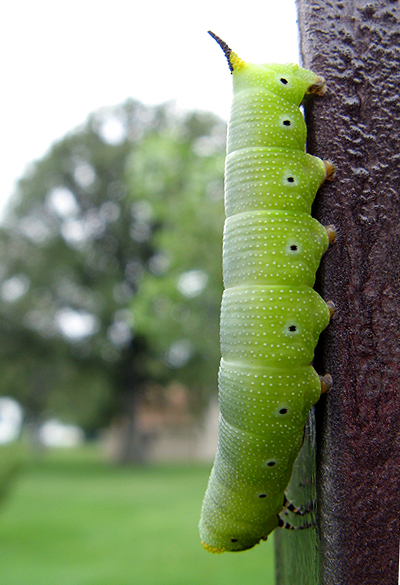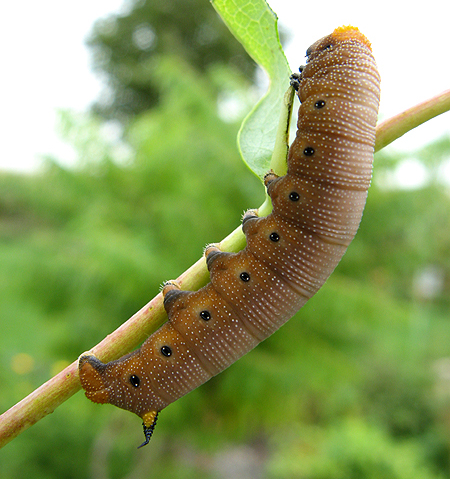Paulding County, Ohio
Sphingidae Larvae
Hemaris diffinis, green form, Paulding County, courtesy of Kylee Baumle.
|
|
Created/dedicated as per personal communication with Kylee Baumle, November 5, 2007 Updated as per James P. Tuttle's The Hawk Moths of North America, September 29, 2013 |

Hemaris diffinis, green form, Paulding County, courtesy of Kylee Baumle.
Kylee writes, November 5, 2007, "I thought you might be interested in these photos I took of Snowberry Clearwing Moth caterpillars (isn't that correct?) found on our Lonicera in September. The green ones were there almost all summer, but this is the only one I saw in the brown stage of development. I even saw a teeny tiny one that was probably no longer than a quarter inch long. I can't believe I actually saw that one.
"We had clearwings a LOT in the garden this year. It was the first time we'd ever seen one and at first I thought it was a hummingbird, but as soon as I got closer, I could see that it wasn't. Then I thought it was a big bumblebee! LOL. I love these beautiful things and am entranced by them when they're visiting."
Kylee also observed an adult Agrius cingulata moth in her yard in October. I indicated that Agrius cingulata would likely only be present in her area as a late summer/fall migrant stray from further south. It would be unlikely to find larvae of that species in her area.
For care of "found larvae/caterpillars" visit Manduca sexta larva, central Texas, August 21, 2008, Trina Woodall.
Thirty-three Sphingidae species are listed for Ohio on the U.S.G.S. website. Not all of the species are reported or anticipated in Paulding County. It is hoped that this checklist, with the thumbnails and notes, will help you quickly identify the larvae you are likely to encounter.
A "WO" after the species name indicates that I have no confirmed reports of this species in Paulding County, but I (William Oehlke) expect that this species is present or might be present. A "KB" indicates the moth or its larva is reported by Kylee Baumle.
Please help me develop this list with improved, documented accuracy by sending sightings (species, date, location), preferably with an electronic image, via email to Bill Oehlke.
Please also send your sightings to BAMONA, an excellent on-line resource.
Visit Paulding County Sphingidae: Adult Moths.
Visit < ahref=Ohiocatocala.htm>Ohio Catocala: Underwing Moths.
Sphinginae subfamily
Smerinthini Tribe:
Macroglossinae subfamilyDilophonotini tribe:
See Hemaris comparison to help distinguish the next three species.
Philampelini tribe:
Macroglossini tribe:
|

Hemaris diffinis, brown form, Paulding County, courtesy of Kylee Baumle.
Enjoy some of nature's wonderments, giant silk moth cocoons. These cocoons are for sale winter and fall. Beautiful Saturniidae moths will emerge the following spring and summer. Read Actias luna rearing article. Additional online help available.
Eggs of many North American species are offered during the spring and summer. Occasionally summer Actias luna and summer Antheraea polyphemus cocoons are available. Shipping to US destinations is done from with in the US.
Use your browser "Back" button to return to the previous page.
This page is brought to you by Bill Oehlke and the WLSS. Pages are on space rented from Bizland. If you would like to become a "Patron of the Sphingidae Site", contact Bill.
Please send sightings/images to Bill. I will do my best to respond to requests for identification help.
 Show appreciation for this site by clicking on flashing butterfly to the left. The link will take you to a page with links to many insect sites. |
I very much appreciate all the many images that have been sent to me, or of which I have been granted permission to copy and post from other websites. All images on this site remain the property of respective photographers.
If you would like to contribute to the maintenace of this website by sending a contribution to
Bill Oehlke
Box 476
155 Peardon Road
Montague, Prince Edward Island, C0A1R0
Canada
your donation would be much appreciated and would be used for
1) paying for webspace rental;
2) paying for computer maintenance and software upgrades;
3) purchases of additional text reference material (journals and books) in anticipation of expanding the site to a worldwide Sphingidae site;
4) helping to pay my daughter's tuition; with anything left over going to humanitarian aid.
If you are mailing a check from USA, please use $0.85 postage. Donations can also be made through Paypal via the button below.